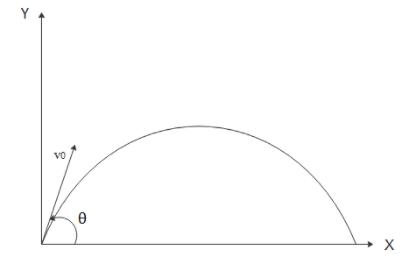
The trajectory of a projectile near the surface of the earth is given as $y = 2x - 9{x^2}$. If it were launched at an angle ${\theta _0}$with speed ${v_0}$ then (g = $10m{s^{ - 2}}$) :
A. ${\theta _0} = {\cos ^{ - 1}}\left( {\dfrac{1}{{\sqrt 5 }}} \right){\text{ and }}{v_0} = \dfrac{5}{3}m{s^{ - 1}}$
B. ${\theta _0} = {\sin ^{ - 1}}\left( {\dfrac{1}{{\sqrt 5 }}} \right){\text{ and }}{v_0} = \dfrac{5}{3}m{s^{ - 1}}$
C. ${\theta _0} = {\sin ^{ - 1}}\left( {\dfrac{2}{{\sqrt 5 }}} \right){\text{ and }}{v_0} = \dfrac{5}{3}m{s^{ - 1}}$
D. ${\theta _0} = {\cos ^{ - 1}}\left( {\dfrac{2}{{\sqrt 5 }}} \right){\text{ and }}{v_0} = \dfrac{5}{3}m{s^{ - 1}}$
Answer
559.5k+ views
Hint: This is the case of projectile motion where the particle is projected with some angle to the horizontal. The acceleration acting on the projectile is only in vertical direction because gravity will be acting only in vertical direction and along horizontal direction there is no force.
Formula used:
$y = x\tan \theta \: - \:\dfrac{{g{x^2}}}{{2{u^2}{{(\cos \theta )}^2}}}$
Complete answer:
When a particle is projected with some angle to the horizontal then that particle will have both horizontal displacement and vertical displacement. Since there will be no force along the horizontal direction the velocity along the horizontal direction will be the same throughout its motion while there is force along the vertical direction so velocity along vertical direction will vary.
Along the horizontal direction let the displacement be ‘x’ and initial velocity be ‘$u\cos \theta $’ and ‘t’ is time and acceleration is zero. Along the vertical direction let the displacement be ‘y’ and initial velocity be ‘$usin\theta $’ and ‘t’ is time and acceleration is $g$
Whereas theta is the angle of projection with horizontal and ‘u’ is the magnitude of initial velocity. Here ‘u’ is given as ${v_0}$. It is denoted clearly in the below figure.

The trajectory we have is $y = 2x - 9{x^2}$
Comparing that with equation $y = x\tan \theta \: - \:\dfrac{{g{x^2}}}{{2{u^2}{{(\cos \theta )}^2}}}$
We have
$y = x\tan \theta \: - \:\dfrac{{g{x^2}}}{{2{u^2}{{(\cos \theta )}^2}}}$
$\eqalign{
& \Rightarrow \tan \theta \: = \dfrac{2}{1} \cr
& \Rightarrow \cos \theta = \dfrac{1}{{\sqrt {{1^2} + {2^2}} }} \cr
& \therefore \cos \theta = \dfrac{1}{{\sqrt 5 }} \cr
& \Rightarrow \dfrac{g}{{2{u^2}{{\cos }^2}\theta }} = 9 \cr
& \Rightarrow \dfrac{{10}}{{2{u^2}{{\left( {\dfrac{1}{{\sqrt 5 }}} \right)}^2}}} = 9 \cr
& \Rightarrow {u^2} = \dfrac{{25}}{9} \cr
& \Rightarrow u = \dfrac{5}{3}{\text{ but }}u = {v_0} \cr
& \therefore {v_0} = \dfrac{5}{3}m{s^{ - 1}} \cr} $
Hence option A is correct.
Note:
The formula which we have is applicable only if the acceleration due to gravity is constant and not varying. We can find the trajectory by finding the range and the angle of projection with the horizontal because the equation of trajectory we have can be written in terms of range too.
Formula used:
$y = x\tan \theta \: - \:\dfrac{{g{x^2}}}{{2{u^2}{{(\cos \theta )}^2}}}$
Complete answer:
When a particle is projected with some angle to the horizontal then that particle will have both horizontal displacement and vertical displacement. Since there will be no force along the horizontal direction the velocity along the horizontal direction will be the same throughout its motion while there is force along the vertical direction so velocity along vertical direction will vary.
Along the horizontal direction let the displacement be ‘x’ and initial velocity be ‘$u\cos \theta $’ and ‘t’ is time and acceleration is zero. Along the vertical direction let the displacement be ‘y’ and initial velocity be ‘$usin\theta $’ and ‘t’ is time and acceleration is $g$
Whereas theta is the angle of projection with horizontal and ‘u’ is the magnitude of initial velocity. Here ‘u’ is given as ${v_0}$. It is denoted clearly in the below figure.

The trajectory we have is $y = 2x - 9{x^2}$
Comparing that with equation $y = x\tan \theta \: - \:\dfrac{{g{x^2}}}{{2{u^2}{{(\cos \theta )}^2}}}$
We have
$y = x\tan \theta \: - \:\dfrac{{g{x^2}}}{{2{u^2}{{(\cos \theta )}^2}}}$
$\eqalign{
& \Rightarrow \tan \theta \: = \dfrac{2}{1} \cr
& \Rightarrow \cos \theta = \dfrac{1}{{\sqrt {{1^2} + {2^2}} }} \cr
& \therefore \cos \theta = \dfrac{1}{{\sqrt 5 }} \cr
& \Rightarrow \dfrac{g}{{2{u^2}{{\cos }^2}\theta }} = 9 \cr
& \Rightarrow \dfrac{{10}}{{2{u^2}{{\left( {\dfrac{1}{{\sqrt 5 }}} \right)}^2}}} = 9 \cr
& \Rightarrow {u^2} = \dfrac{{25}}{9} \cr
& \Rightarrow u = \dfrac{5}{3}{\text{ but }}u = {v_0} \cr
& \therefore {v_0} = \dfrac{5}{3}m{s^{ - 1}} \cr} $
Hence option A is correct.
Note:
The formula which we have is applicable only if the acceleration due to gravity is constant and not varying. We can find the trajectory by finding the range and the angle of projection with the horizontal because the equation of trajectory we have can be written in terms of range too.
Recently Updated Pages
Why are manures considered better than fertilizers class 11 biology CBSE

Find the coordinates of the midpoint of the line segment class 11 maths CBSE

Distinguish between static friction limiting friction class 11 physics CBSE

The Chairman of the constituent Assembly was A Jawaharlal class 11 social science CBSE

The first National Commission on Labour NCL submitted class 11 social science CBSE

Number of all subshell of n + l 7 is A 4 B 5 C 6 D class 11 chemistry CBSE

Trending doubts
What is meant by exothermic and endothermic reactions class 11 chemistry CBSE

10 examples of friction in our daily life

One Metric ton is equal to kg A 10000 B 1000 C 100 class 11 physics CBSE

1 Quintal is equal to a 110 kg b 10 kg c 100kg d 1000 class 11 physics CBSE

Difference Between Prokaryotic Cells and Eukaryotic Cells

What are Quantum numbers Explain the quantum number class 11 chemistry CBSE




